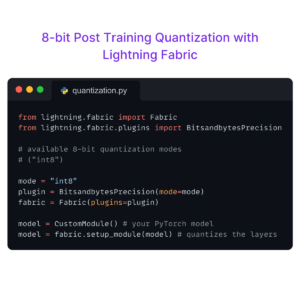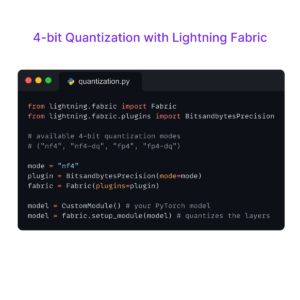Takeaways
Learn how to gain the technical skills to break into AI after a successful military career.#Veterans

Uncle Sam generated with Stability AI’s DreamStudio
There are a variety of ways to break into AI as a veteran.
College is a tried and true route. Software Engineering and Data Science boot camps are increasing in popularity and are becoming acceptable alternatives to college by companies. Self-paced courses on Coursera and edX are also becoming more widely accepted in industry. Contributing to open-source projects is also a viable way to gain skills in a very public and verifiable manner alongside a potential employer.
The bottom line is: you need to become technical if you want to get into AI and the best way to hear how others are tackling this journey is to join our Discord server.
Veterans at Lightning AI
We have multiple veterans on the team, including our own founder – William Falcon – who served in the United States Navy before attending Columbia and NYU, and launching Lightning AI. We also have Eden – an IDF veteran and Senior Product Manager. Last but not least – I retired from the United States Marine Corps as an EOD Technician before earning an MS in Artificial Intelligence and joining Lightning AI.
Making Your Way Through the Fray
My personal journey into AI after departing the Marine Corps included a simultaneous mix of college, self-paced courses on DataCamp and Codecademy, and contributing to Lightning AI for about one year before joining the team.
My path is not the only path – each veteran’s journey is going to be unique, however, there are some high-level challenges that everyone may have in common:
- Pivoting to an entirely new skill set.
- Acquiring skills in a relevant credentialing program.
We’ll cover these topics below in greater detail, but first, let’s start with a disclaimer – there are no real shortcuts – again, you need to become technical if you want to get into AI. This is going to involve the same determination as it did during your service. Will, Eden, and I did it, and so can you! A simple roadmap of how is outlined below.
College: Using your G.I. Bill
When it comes to considering a career in AI – attending college allows you to really grasp the foundational concepts of AI and machine learning in a classroom setting with the support of a professor, teaching assistants, tutoring centers, and classmates.
Also, attending college isn’t exactly the bottleneck you think it might be – I unpack this more below by discussing what I learned about the G.I. Bill and calling out some of the added benefits that I experienced during my own time in college.

Special Considerations for STEM Programs
Did you know that the VA offers a 9-month GI Bill extension for STEM programs? This would give you up to 45 months of education benefits to complete your degree, making higher education in AI even more accessible to veterans.
It’s also worth pointing out that the number of months you have to complete your degree isn’t calendar time – it is training time. In other words, if you start college in September of 2023, you don’t have to complete your degree by September 2026. You can take summers off and attend part-time! This makes it possible to take fewer classes when a particular combination of courses might be difficult for you, which was the exact tactic I used when I had to take multiple math classes in a semester.
Finding a College That’s Right for You
Organizations like the Warrior Scholar Project can help you find your way into universities like MIT, Princeton, and Harvard, but don’t be discouraged if an Ivy League university isn’t for you. At a minimum, the university you choose should be ABET-accredited and R1 or R2 research focused with a co-op program or on-campus recruiting office built around established relationships with technology companies so you can get hands-on experience in industry.
Additional Assistance: The Yellow Ribbon Program
In addition to the STEM extension, there’s also the Yellow Ribbon Program. The Yellow Ribbon Program can help you pay for higher out-of-state, private school, foreign school, or graduate school tuition and fees that the Post-9/11 GI Bill doesn’t cover.
Getting Over the Math Mountain
Math is hard – I get it – because I was a 36-year-old computer science and engineering student who hadn’t opened a serious math book in nearly 20 years before venturing into pre-Calc and Intro to Linear Algebra. My success in the required math and artificial intelligence courses was part stubborn refusal to give up, and smart use of tools like Symbolab and Wolfram Alpha. There are also amazing YouTube channels like 3Blue1Brown, and StatQuest by our own Joshua Starmer, that you can use to review math and stats concepts.
Bootcamps: Using the G.I. Bill for VetTech
The VA also supports alternative learning in technology boot camps with a program called VetTec. Veterans can use this program to gain experience to start a career in software engineering and data science – each of which can lead to careers in artificial intelligence. While using VetTec, veterans are eligible for tuition for a full-time training program and housing benefits.
There are a few dozen training providers that are approved to offer services to veterans through the VetTec program – which can make selecting the right program difficult. I’ve had the opportunity to meet with one of those providers – Code Platoon, and am completely comfortable recommending that veterans at least consider their Full-Stack Software Engineering and DevOps Engineering programs.
Finding a Job in AI

While LinkedIn is great for connecting with other veterans at large corporations, I’ve found it somewhat difficult to use to locate jobs with startups – Wellfound (formerly AngelList Talent) was my tool for that prior to joining Lightning.
A large ecosystem of AI companies exists that can be found by exploring the “portfolio” page of tech incubators and venture capital firms such as: Coatue ,The Engine, NEA, Insight Partners, Techstars, a16z, and ycombinator. By navigating to the portfolio page, you will see which companies the VC or incubator has invested in or is supporting, and then travel to the “careers” page of each of those portfolio companies to look for openings.
Preparation and Placement
Companies exist that can help guide you through your journey into AI, and tech in general. One such company is BreakLine Education, and the veteran specific track that is listed on their programs page. The highlights of Breakpoint’s program are that the program is free, you can attend remotely, and they have a pretty impressive list of hiring partners that includes Anduril, Meta (Facebook), HashiCorp, Google, and Palantir.
On-the-Job Training: DOD SkillBridge
DOD SkillBridge is a program that “is an opportunity for service members to gain valuable civilian work experience through specific industry training, apprenticeships, or internships during the last 180 days of service. SkillBridge connects service members with industry partners in real-world job experiences”. Eligible members can search for opportunities on the official portal.
Another option to land a SkillBridge internship, is to enlist the help of fellow veterans at Shift by way of their SkillBridge placement program.
Beyond the Classroom: Contributing to Open Source
College and boot camps can give you foundational AI skills to understand basic theory and programming, and you’ll eventually need to build on that foundation by becoming more proficient with Python and working in a team. Contributing to open source projects can do just that, and the nice thing about contributing is that you do not need to apply in the same sense as applying to an internship. You can learn how to get started by reading How to Contribute to Lightning, and I’ve also shared some of my experience below.

Getting Started
About a month after I graduated from my M.S. program, I began contributing to PyTorch Lightning, one of Lightning AI’s open source frameworks and libraries.
Why did I begin? I realized that learning AI/ML by simply writing code in notebooks wasn’t enough to become a fully-fledged Research Engineer. I had been educated in the foundations of theory, but had gaps in my software engineering skills that needed to be closed.
How did I begin? I first considered which Python libraries and frameworks I enjoyed using the most in my courses and which of those projects was actively merging community pull requests – PyTorch Lightning was that framework. After landing on PyTorch Lightning, I got a sense of the requirements and design principles by reading the Contributing page in the docs. Also, finding out that Will is a fellow veteran made me want to work with Lightning AI even more!
Working with Lightning AI’s Engineers
Once I started opening issues and submitting pull requests, Lightning AI’s engineers began to communicate with me in GitHub on my pull requests, and eventually in Slack direct messages and virtually in Google Meets. As these relationships developed, I realized that contributing is a way to earn code reviews and feedback from very experienced engineers.
Contributing helped level up my Python skills to the point that I could implement new features into the PyTorch Lightning framework and TorchMetrics. I also learned how to write unit tests with PyTest and implement CI/CD in GitHub Actions and CircleCI – concepts not covered at all during my university studies, but that are required to become a research engineer working in industry.
This may sound like a lot to learn – because it is! Be encouraged though, and don’t be afraid of jumping in. We are a group of individuals who have tremendous industry and academic experience waiting to help, and with nearly a third of our team having earned PhDs and the remainder being senior engineers from the likes of Google, Meta, Julia, and Red Hat, you are in good hands!
Hard Work Pays Off!
Lastly, I should point out that contributing consistently over the course of a year likely earned me my role at Lightning. My contributions caught the eye of engineers, developer advocates, and eventually, the CEO and VP of People. It was a long process, but now I am at a top AI startup – and I can tell you: it was worth it.

Thank You
We understand that the sacrifices you have made, and we want to extend a heartfelt thank you to you and your families. As part of our thanks, we want to make sure we are doing our part to help veterans pursue careers in this incredible field, so join our Discord server – see you there!


